What Are the Best Quizlet Decks for AP Art History?
5 min read•july 11, 2024
J
Jordyn Haynes
AP Art History 🖼
34 resourcesSee Units
Best Quizlet Decks for AP Art History
When studying pieces of art, using flashcards can be an amazing tool to help with memorization and learning key facts. Thankfully, Quizlet makes it easy for students to find hundreds of stacks of flashcards online. We've sorted through this mass amount of information and found the very best Quizlet decks for AP® Art History students!
🧠 Memorizing 10 pieces of art is a challenge, let alone 250! In this Quizlet deck, you'll find a card for each of the 250 required works for AP Art History.
Good luck studying! For more tips on how to get that 5, check out this guide! If you need more information about the exam itself, and its format, we've got your back as well!
Unit 1: Global Prehistory, 30,000-500 BCE
🐎
Because art from this period is old, interpretations for each work are quite open. Common themes/ideas include rituals or spirits, as in that the art piece was used in a ritual or represented a spirit in some way. You’ll find that art from this period involves a lot of zoomorphic (animal) characteristics and often uses rocks/stone as a medium or backdrop for the work.
Best Quizlet Deck: AP Art History: Unit 1 by mbaginski
Key terms:
- Ideogram: a simple, picture like sign filled with implicit meaning.
- Naturalism: art should adhere as closely as possible to the appearance of the natural world. Naturalism, with varying degrees of fidelity to appearance, recurs in the history of Western art.
- Twisted Perspective: AKA Composite View - representation in which part of a figure is in profile and other parts of the same figure are shown frontally.
Unit 2: Ancient Mediterranean, 3500 BCE-300CE
🏛
Art from this unit greatly impacted later styles (e.g. neoclassicism) and even other styles within the same unit (e.g. Egyptian influence on Greek art, Greek influence on Roman art, etc.).
Religion and history integrate into these works. Art in this unit is mainly from the ancient civilizations of the Near East.
Best Quizlet Deck: Unit 2: Ancient Mediterranean, 3500 BCE-300 CE by CSailingT
Sample Card for Unit 2
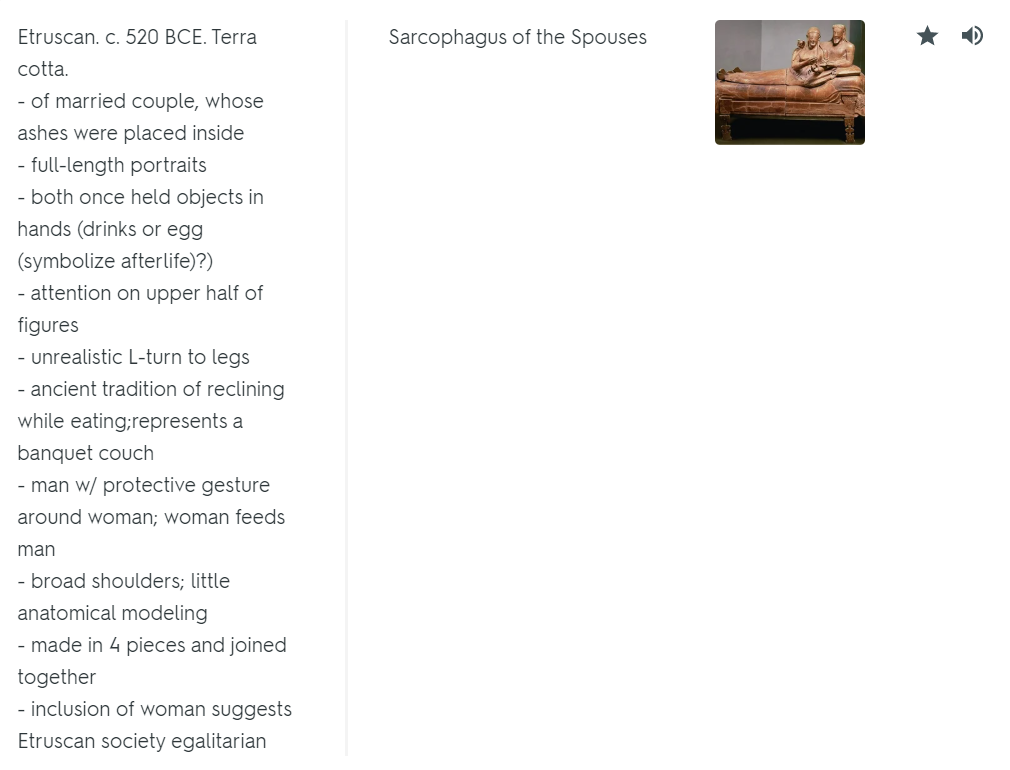
Unit 3: Early Europe and Colonial Americas, 200-1750 CE
⛪
Early Christianity is present in many of these works, which often include depictions of biblical figures and churches. Also, the use of religion to elevate a monarch’s power is present, and there are mentions of Islamic and Jewish works. This unit introduces both secular and satirical art (though they are separate) as well as introduces the reclining female nude.
Sample Card for Unit 3
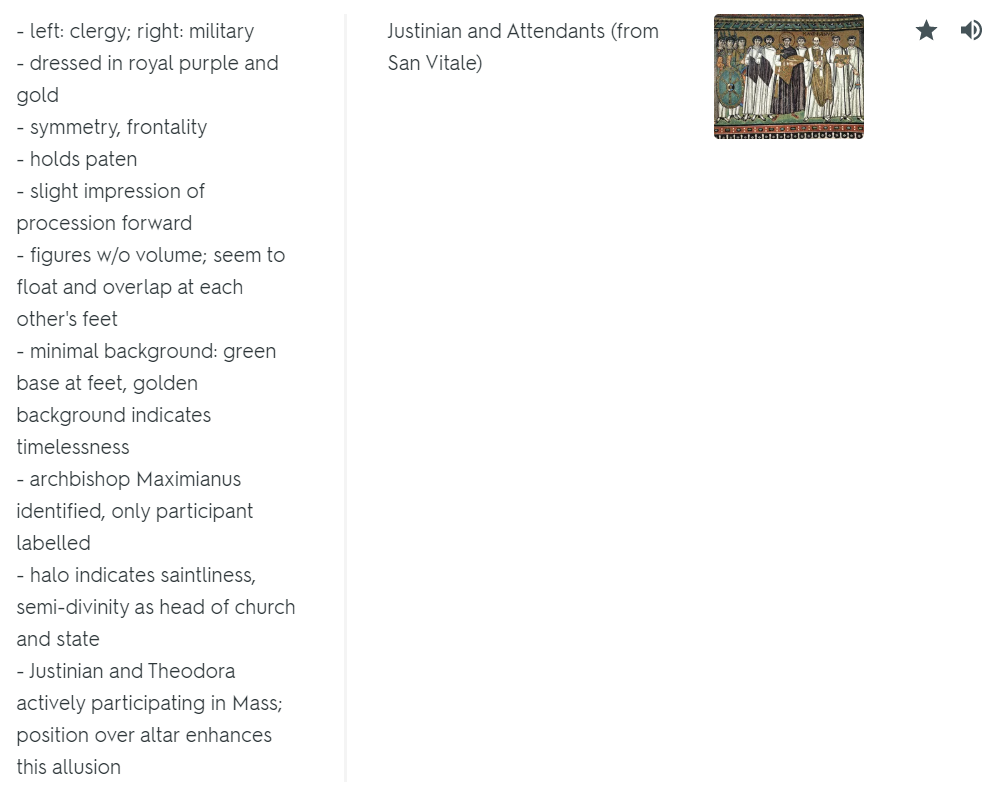
Unit 4: Later Europe and Americas, 1750-1980 CE
📸
Rapid innovations in industry and technology called for shifts in style and culture. Changing times resulted in numerous movements with different goals. Photography entered the realm of art; consequently, there was conflict over whether or not it should be considered art.
There were callbacks to earlier times (neoclassicism) and influenced different cultures (as exemplified by Paul Gauguin’s Where Do We Come From? What Are We? Where Are We Going? and Pablo Picasso’s Les Demoiselles d’Avignon).
People began to push the limits of what could be considered art, and different movements often outraged the public.
Sample Card for Unit 4
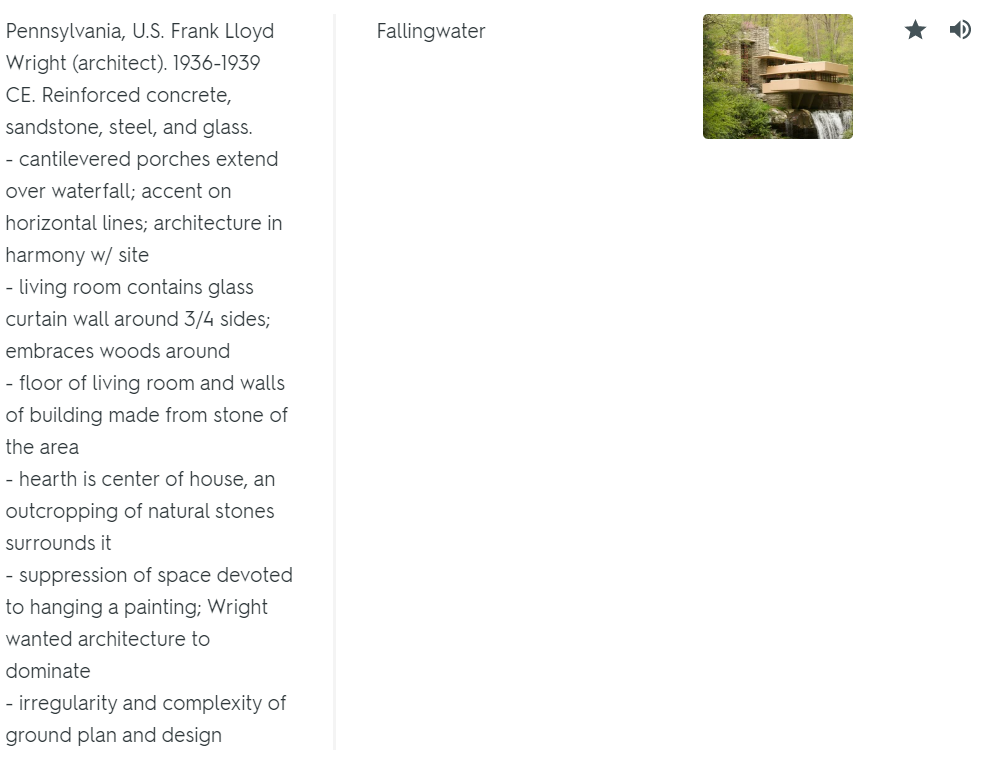
Unit 5: Indigenous Americas, 1000 BCE-1980 CE
🗿
Like many of the other units, there’s a strong connection to religious beliefs and social hierarchies. However, there’s also the addition of astronomy (ex. the observatory at Machu Picchu and Templo Mayor) and, later, the impact of European expansion into the Americas.
Because large civilizations were located mostly in Meso and South America, works from those areas include large structures/buildings/cities, while North American works are generally smaller.
Sample Card for Unit 5
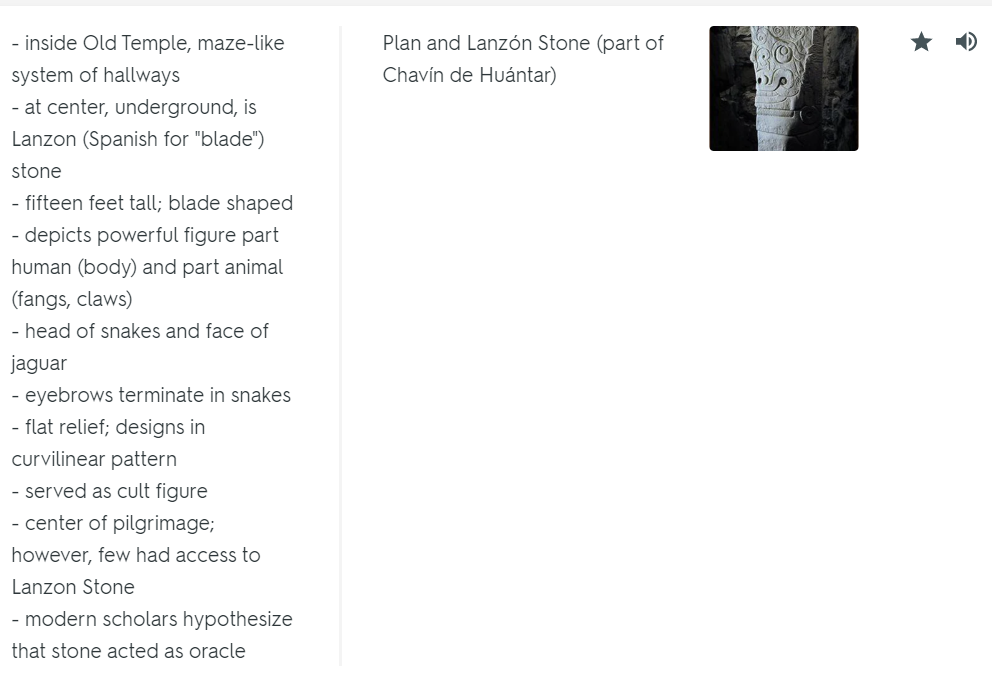
Unit 6: Africa, 1100-1980 CE
👺
Art, in this unit, have practical uses, like for remembering history and for use in religious and ceremonial rituals. A common theme was the presence of high status. Wood was used as the medium
African masks (which, as you’ll see, are abundant in variety) inspired Western painters like Pablo Picasso. The starkest influence on Picasso’s work is with Les Demoiselles d’Avignon.
Best Quizlet Deck: Unit 6: Africa, 1100-1980 CE by CSailingT
Sample Card for Unit 6
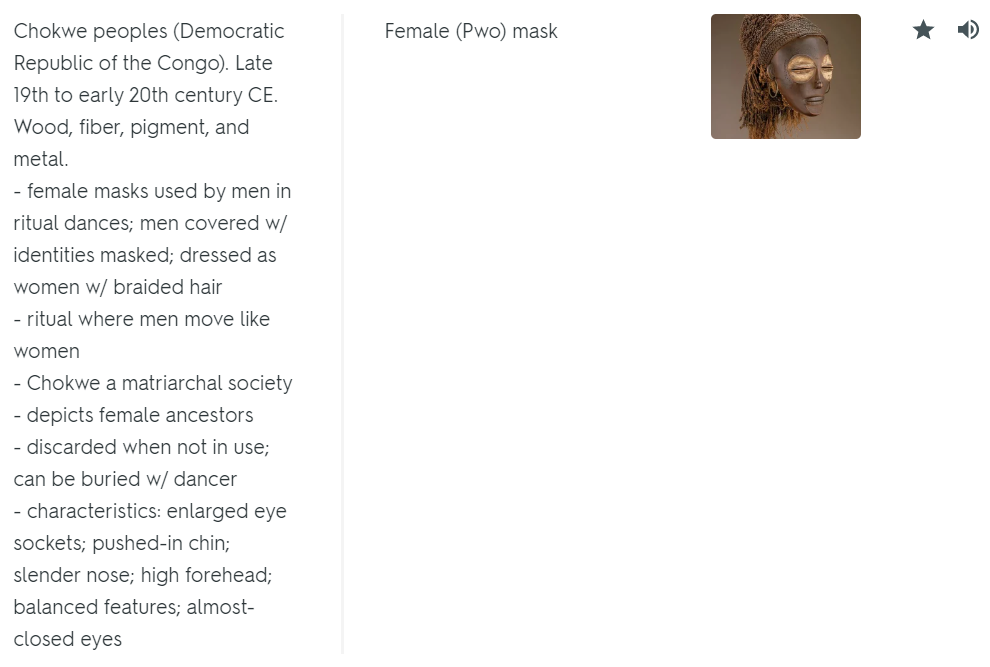
Unit 7: West and Central Asia, 500 BCE-1980 CE
🕋
Within this unit, the religions of Islam and Buddhism were the most prevalent. Works used extreme, minute details and geometric designs, especially with Islamic art, since icons aren’t allowed. Also, gold is a common feature.
Large places of worship serve as points for pilgrimage, the most famous of which is The Kaaba, where Muslims go to complete the hajj, one of the five pillars of Islam.
Sample Card for Unit 7

Unit 8: South, East, and Southeast Asia, 300 BCE-1980 CE
🛕
In this unit, Buddhism and Hinduism are the prominent religions. History and displays of power are present, especially with large architectural works like the Taj Mahal and the Forbidden City.
There are many temples, which are destinations for religious pilgrims. The architecture of this unit includes the use of statues, as with the Lakshmana Temple.
Sample Card for Unit 8
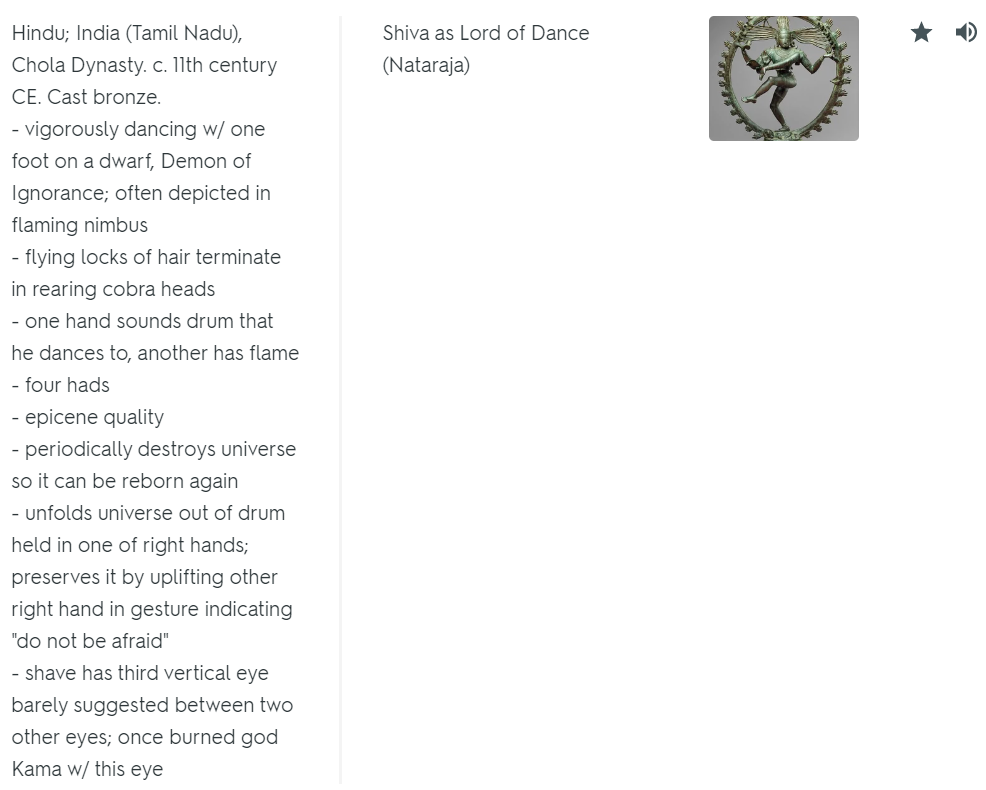
Unit 9: The Pacific, 700-1980 CE
🐚
Rituals and ceremonies used many of these art pieces as objects. Materials used are the ones that were available to the islanders, including shells, wood, feathers, and boulders.
Men usually carved with wood while women weaved. Common themes referenced ideas of social status, spirits/deities, and local beliefs of the islanders.
Sample Card for Unit 9
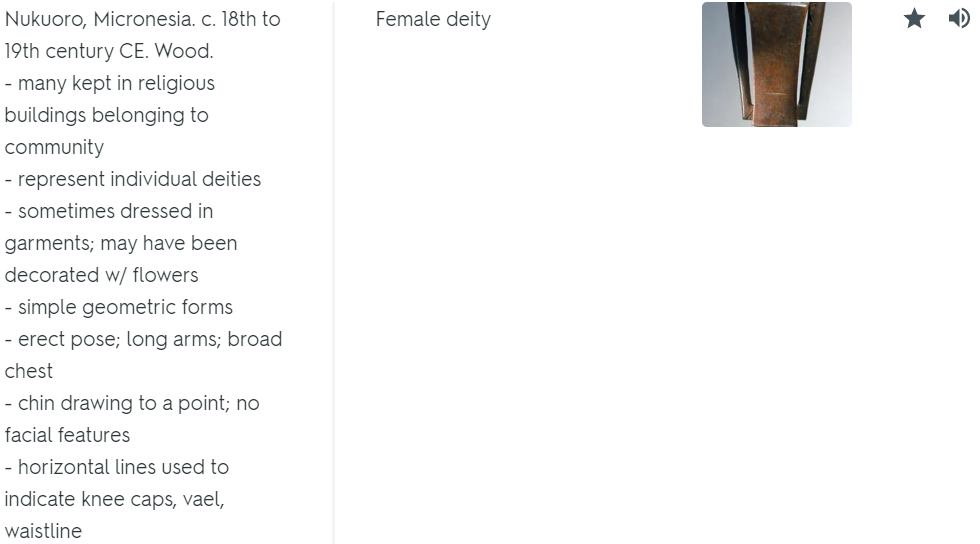
Unit 10: Global Contemporary, 1980 CE to Present
🏙
Finally, a unit that focuses on art from everywhere! As the word global implies, art is now from all over the world, rather than the previous art hubs of Paris, France, then New York City, US, or of a specific culture. Each work strives to make a clear (somewhat clear, at least) point--about culture, roles of women, historical events, modern trends, etc.
Computers and other new technology are present, and the impact of them in the world of art is prominent in works that include videos, such as Bill Viola’s The Crossing and Mariko Mori’s Pure Land. The Guggenheim Bilbao Museo art museum in Spain uses software-generated floor plans.
Sample Card for Unit 10
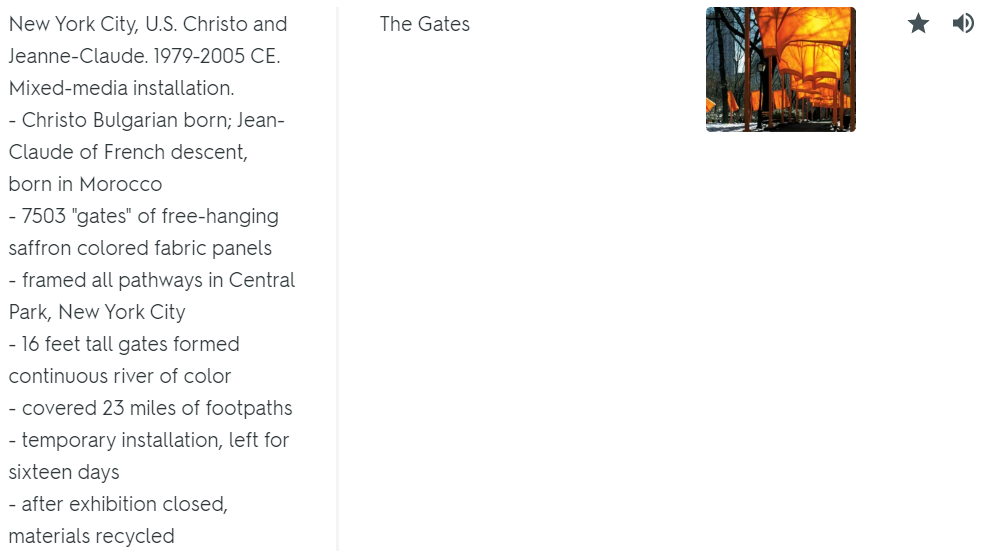
Browse Study Guides By Unit
🗿Unit 1 – Global Prehistoric Art, 30,000-500 BCE
🏛Unit 2 – Ancient Mediterranean Art, 3500-300 BCE
⛪️Unit 3 – Early European and Colonial American Art, 200-1750 CE
⚔️Unit 4 – Later European and American Art, 1750-1980 CE
🌽Unit 5 – Indigenous American Art, 1000 BCE-1980 CE
⚱️Unit 6 – African Art, 1100-1980 CE
🕌Unit 7 – West and Central Asian Art, 500 BCE-1980 CE
🛕Unit 8 – South, East, and Southeast Asian Art, 300 BCE-1980 CE
🐚Unit 9: The Pacific, 700–1980 ce
🏢Unit 10 – Global Contemporary Art, 1980 CE to Present
📚Study Tools

Fiveable
Resources
© 2025 Fiveable Inc. All rights reserved.